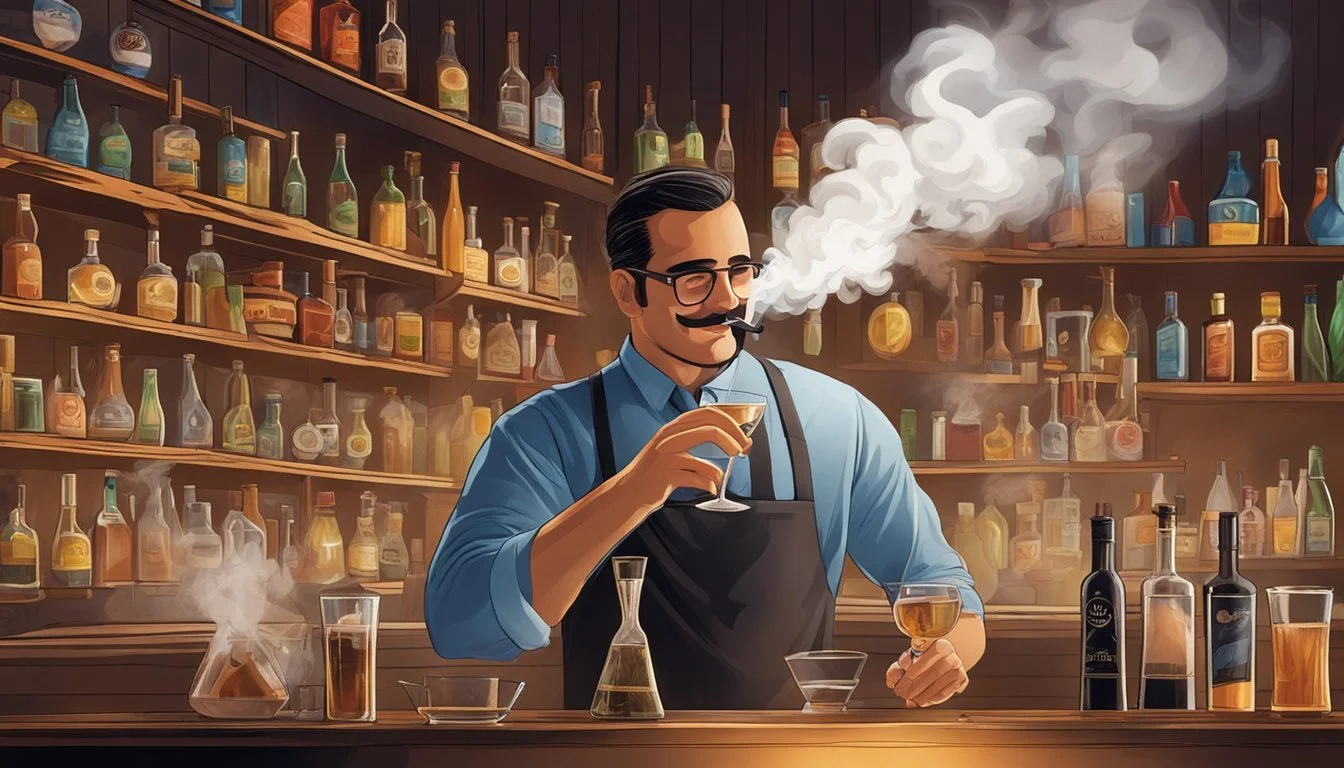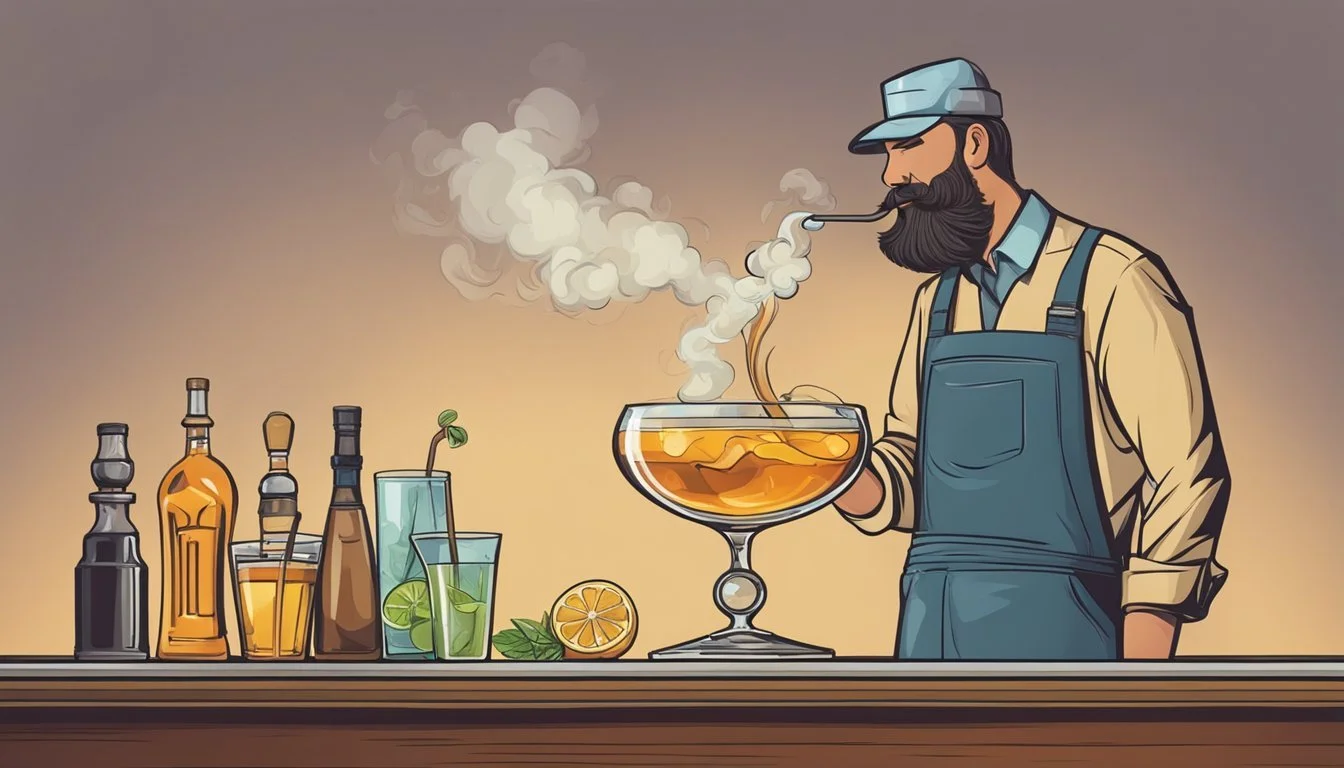The Art of Smoking Cocktails with Texas Wood
Elevating Drink Flavors Naturally
The practice of infusing smoky flavors into cocktails is an inventive approach that takes the sensory experience of enjoying a drink to new heights. By introducing the rich, aromatic qualities of smoke, mixologists are elevating the cocktail game to an art form. Using the distinctive woods native to Texas, such as post oak, adds a unique dimension, infusing drinks with a robust and regional essence. This practice pays homage to the heritage of Texas barbecue, renowned for its bold and smoky flavors, and seamlessly transitions that legacy into the realm of mixology.
Incorporating smoke into a cocktail requires precision as well as creativity. It's a deliberate process where the type of wood and the duration of smoke exposure are crucial to achieving the right balance. Too much smoke can overpower the cocktail, while too little might not impart the desired flavor profile. Texas wood, known for its strong character, offers a particularly pronounced smoke that must be used thoughtfully to complement, rather than dominate, the drink's other components.
Understanding the nuanced characteristics of different Texas woods and how they pair with various spirits is essential. For instance, cherry wood imparts a fruitier note that can elevate the natural flavors of whiskey without overshadowing its complexity. Craftsmanship in smoking cocktails involves not just altering the taste but also the aroma and visual presentation, altogether creating a comprehensive sensory experience that transforms the act of drinking a cocktail into an immersive indulgence.
Essentials of Smoking Cocktails
The essence of smoking cocktails lies in the intricate play between aroma and flavor, elevating the sensory experience. Mastering the use of smoke and wood chips is key to crafting an exceptional smoked cocktail.
What Is Cocktail Smoking?
Cocktail smoking is the process of infusing a drink with smoke to impart unique flavors and aromas. It is accomplished by using tools such as a smoking gun which directs smoke into a covered glass or decanter containing the cocktail. The smoke, originating from a variety of wood chips, interacts with the drink on a molecular level, altering its taste and olfactory profile.
Importance of Aroma and Flavor
The heightened aroma and enriched flavor are what set smoked cocktails apart. Aroma plays a pivotal role in perception of taste, with nearly 80% of flavors attributed to the sense of smell. Introducing smoke to a cocktail adds a new aroma dimension that significantly changes its overall flavor profile.
The Science of Smoke
The science behind smoke infusion relies on the type of wood used. Different woods release distinct compounds when burned:
Fruit wood produces a subtle, sweet smoke.
Hard wood offers a stronger, more intense smokiness.
When burning wood chips in a smoking gun, smoke compounds envelop the liquid, binding with it to create a deep, complex taste. This technique, known as smoke-rinsing, can be performed directly in the glass to lend a light smoky hint, enhancing the cocktail’s aroma without overwhelming its other components.
Selecting the Right Wood
The craftsmanship in smoking cocktails hinges greatly on the wood used. Different types of wood impart distinct flavor profiles, influencing both the smoke's aroma and the overall taste of the cocktail.
Varieties of Wood for Smoking
Texas is known for its bountiful selection of wood suitable for smoking, each bringing its unique character to a cocktail. Classic options include:
Hickory: Robust and smoky.
Oak: Strong, but not overpowering, with a traditional smokiness.
Mesquite: Intense and earthy.
Applewood: Mild sweetness and a fruity touch.
Cedar: Offers a spicy edge.
Pecan Wood: Similar to hickory but with a lighter, nuttier flavor.
Maple Wood: Slightly sweet and smoky.
Cherry Wood: Fruity and sweet with a soft profile.
Flavor Profiles of Different Woods
The following table outlines the flavor profiles of the most common woods used in smoking cocktails:
Type of Wood Flavor Profile Intensity
Hickory Strong, bacon-like High
Oak Balanced smokiness, versatile Moderate
Mesquite Sharp, earthy High
Applewood Sweet, subtle fruit notes Mild
Cedar Spicy and fragrant Varies
Pecan Wood Nutty, mellow Mild-Moderate
Maple Wood Smoky sweetness Mild
Cherry Wood Slightly sweet and fruity Mild
Wood Selection Tips
Choosing wood for smoking cocktails isn't just about the type; one must also consider:
The flavor profile of the cocktail: A lighter wood like applewood might complement a cocktail with a delicate spirit base, whereas a robust spirit may stand up to the intensity of mesquite.
Preparation: To moderate the intensity, chips or chunks should be soaked in water prior to smoking.
Experimentation: Trial and error lead to finding the perfect match between wood and cocktail, enhancing the enjoyment of both components.
Techniques and Tools
Smoking cocktails is an art that enhances the sensory experience by imparting complex aromas and flavors. Mastery of the right techniques and tools is essential for creating the perfect smoked cocktail.
Smoking Techniques
To infuse a cocktail with a smoky flavor, one can employ various smoking methods. Cold smoking is a technique where smoke is introduced at ambient temperatures. This method does not cook the cocktail ingredients but instead gently infuses them with smoke, ideal for a subtle aroma and flavor. To capture the smoke directly in the cocktail, mixologists often use a cocktail shaker, sealing it briefly with smoke before shaking.
In contrast, hot smoking applies heat and smoke simultaneously, imparting a more robust smoky flavor. This method is typically reserved for ingredients that can withstand the direct heat without spoiling the cocktail's taste or texture.
How to Use a Smoking Gun
A smoking gun is a popular tool for infusing cocktails with a smoky essence. To use a smoking gun:
Fill the chamber with wood chips, typically of Texas origin such as mesquite for an earthy tone or post oak for its robust profile.
Light the chips with a torch, and allow the smoke to billow.
Direct the smoke into a covered container or cocktail shaker with the cocktail or ingredients inside.
Once adequately infused, remove the smoke source and proceed to stir or shake the cocktail as desired.
The smoking gun offers precision and convenience, allowing mixologists to control the intensity and duration of the smoke exposure.
Alternative Smoking Methods
Besides the smoking gun, there are other methods to infuse the smoke into cocktails. One can utilize a handheld torch to char wood directly in the glass, which is then covered to allow the smoke to permeate the drink. Another technique involves creating a smoky dome, where the prepared cocktail is placed under a glass dome filled with smoke, enchanting the audience with visual flair.
These tools and techniques allow bartenders to explore the smoky possibilities and craft drinks that engage all the senses.
Crafting Smoke-Infused Cocktails
Smoke-infused cocktails blend the deep flavors of Texas wood with classic mixology to create an alluring drinking experience. An art in its own right, the infusion of smoke into cocktails requires precision, a knack for balancing flavors, and an understanding of technique.
Classic Cocktails with a Smoky Twist
Classic cocktails gain new life with the addition of smoke. A Smoked Old Fashioned becomes richer with a hint of hickory or oak, elevating the traditional combination of bourbon, sugar, and bitters. Similarly, a Smoked Manhattan benefits from applewood smoke, providing a subtle, fruity backdrop to the blend of whiskey and sweet vermouth. Smoke-rinsing—an approach where the glass is infused with smoke before the drink is poured—adds an enigmatic flavor without overpowering the cocktail.
Recipe for Smoked Old Fashioned:
Ingredients:
2 oz Bourbon
1 Sugar cube
Few dashes of Angostura bitters
Orange peel
Ice cubes
Oak or hickory wood chips for smoking
Method:
Muddle the sugar cube and bitters with one water dash.
Add bourbon and ice, and stir well.
Smoke-rinse the serving glass and strain the cocktail into it.
Garnish with an orange peel.
Creating Your Own Smoked Cocktails
One may venture beyond classics by creating smoked cocktails with personal flair. Start with a base spirit like bourbon or mezcal—the latter already carries a natural smokiness. Choose a wood that complements the spirit's flavor profile; mesquite for boldness, applewood for sweetness. Use a cocktail smoker or a smoking gun to infuse the drink, letting the smoke linger and intermingle with the cocktail's ingredients for a brief period before serving.
Balancing Smoke with Cocktail Ingredients
The key to mastering smoked cocktails is balance. The smoke should accentuate, not mask, the cocktail's components. For a Whiskey Sour, lemon's acidity cuts through the smokiness, while in a smoked cocktail using mezcal, the spirit's inherent smoky character pairs with citrus or agave sweetness. In mixology, harmony between the smoky notes and the rich, aromatic profiles of spirits like whiskey creates a sophisticated layering of flavors.
Guidelines for Balancing Smoke:
Intensity:
Soft Smoke: Use fruitwood like cherry for a delicate touch.
Robust Smoke: Opt for hickory or mesquite for a stronger impact.
Time:
Infuse smoke for 15 to 30 seconds for a subtle nuance.
For bolder flavor, extend the infusion up to a minute.
Combination:
Pair lighter woods with clear spirits.
Use heavier wood types for dark spirits like bourbon and whiskey.
Advanced Cocktail Smoking
In crafting smoked cocktails, the skill lies in the precise application of smoky aroma and the harmonization of flavor profiles. This nuanced process elevates the drinking experience through both taste and theatrical flair.
Infusing Drinks with Smoke
To infuse a cocktail with a rich, smoky flavor, one must carefully select the wood type, as Texas woods like mesquite or hickory impart distinct profiles. Charring the wood to the right degree before using it in the smoking process is crucial for a controlled release of aromatic smoke. Cocktails can be smoked using different apparatus such as a glass dome or a handheld smoker, creating an enveloping cloud of smoke that infuses the drink.
Method 1: Enclose the cocktail under a glass dome filled with smoke for several minutes.
Method 2: Directly infuse the drink with a handheld smoker, ensuring the smoke circulates within the glass.
Garnishes and Layers of Flavor
Garnishes are not just decorative; they can also introduce layers of flavor. Smoked rosemary is an excellent garnish, adding a visually appealing dimension as well as a complex aromatic profile when torched. It's not just about the eye appeal; the burnt rosemary can entwine its essence with the smoky aroma, contributing to the cocktail's overarching sensory profile.
Suggestion: Pair smoked garnishes with cocktails that have complementary flavor profiles.
Example: A citrus-based cocktail might benefit from the addition of a smoked rosemary sprig.
Mastering the Art of Cocktail Smoke
Mastering cocktail smoking involves understanding the subtleties of flavor and how different types of smoke interact with various cocktails. One might infuse smoke into the drink through tea leaves for a lighter, more floral aroma, or opt for the deep intensity of charred wood. Each ingredient must be selected to contribute to the final flavor profile while not overpowering the primary elements of the cocktail.
Tips:
Experiment with different smoking materials to find the perfect match for your cocktail's flavor profile.
Be mindful of the duration of smoke infusion, as prolonged exposure can lead to bitterness.
Practical Tips and Advice
In the nuanced craft of cocktail smoking, precise techniques and safety are paramount. The use of Texas wood, such as post oak, must be managed with care to avoid overwhelming the drink's flavors.
Maintenance and Safety Tips
Regular maintenance is crucial for both the quality of smoke infusion and the longevity of smoking instruments. One should always clean their smoking apparatus after each use to prevent resin build-up, which can alter the intended flavor profile of the smoke. When using cedar planks or applewood chips, it is essential to:
Monitor the wood to ensure it’s smoldering, not burning.
Keep a fire extinguisher handy to address any accidental flare-ups safely.
Innovative Smoking Tricks
Cocktail enthusiasts can elevate their creations by incorporating herbs and spices into the wood chips for a more complex flavor. For instance, adding a cinnamon stick or a sprig of rosemary can introduce a warming and aromatic dimension to the drink. Other innovative tricks include:
Drizzling honey or maple syrup over the wood chips for a subtle sweetness.
Experimenting with different wood types, observing how each interacts with the cocktail ingredients, such as sweet vermouth in a smoked Manhattan.
Elevating the Home Bar Experience
To master the art of smoking cocktails at home, one must not shy away from trying new combinations. The key lies in finding a balance that complements the cocktail's profile, such as pairing applewood chips with lighter spirits or cedar planks with richer, full-bodied concoctions. A few pieces of advice:
Select applewood chips for drinks that benefit from a hint of fruit.
Incorporate sweet vermouth and maple syrup in recipes to match the complex notes introduced by the smoke.






